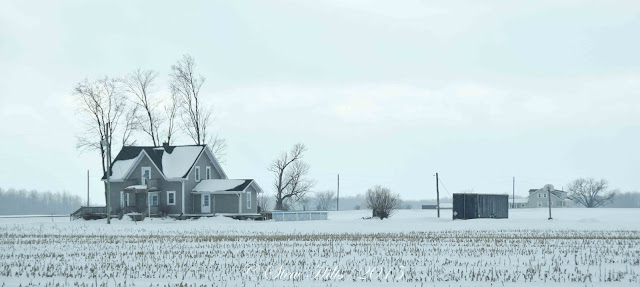We are in the midst of a huge transition in the farming economy here, from older 100 acre farms with their bank barns, and small cattle herds to a more diverse modern farm economy of larger farms with modern barns and more scattered rural non-farm residences. There are fewer hay fields and more cash crops; farm enlargement goes on apace.
On quite a few properties the barn has been demolished. The property has probably been bought by another farmer and the house rented out or severed and sold, but the farmer had no further use for the barn. All part of farm enlargement.Quite often we see modern homes built on the corner of farm properties. Planning law here does not allow more than one residence on a farm normally, nor can the farmer subdivide his land. In a compromise farmers are often allowed a single 'retirement lot' for themselves. But research has shown that the average farmer only stays in such an isolated lot for three years, after which it's sold to a non-farm resident.
In some areas you get a much more open landscape, often of one huge field as former farm buildings disappear entirely.
And on other farms farmers just continue with their older buildings; these are usually small beef operations.










I enjoyed seeing your selection of photographs, sorry those pigeon weren't owls!
ReplyDeleteAll the best Jan
Interesting info about farming in the area. Lots of old farm properties here. Not many young people taking up the challenge. Great photos FG.
ReplyDeleteI find it interesting to hear how farming is evolving over the years. And your pictures and commentary are fascinating. :-)
ReplyDeleteIt's been interesting seeing the change from agriculture to non.
ReplyDeleteI love those old farm houses. We still have a lot of the little farms around about here yet. I walked past many of them. :)
ReplyDeleteWonderful winter scenes.
Barns and farmhouses are going the same way here -- except many of the farms are/have been subdivided and are now growing houses instead of crops. In some areas Amish farmers are buying every farm that comes up for sale and are keeping them as farms since they can apparently have an economically viable operation on 60-100 acres.
ReplyDeleteTimes are a changing. Grandfather's farm sold to a development company and the house with buildings that wanted them for his hobby.
ReplyDeleteBe Safe and Enjoy!
It's about time.
I grew up on a farm but we had no barn as we didn't have livestock. My brother has a newer one on his acreage. It's just not the same as the old ones but like your province most have been torn down.
ReplyDeleteTake care, stay well!
Homes in open fields with a lot fo snow, I would like to see at least several feet above the ground level. a friend's son lives in British Columbia, and there they often have snow above the first of the 3 levels, and he built a huge tall ramp for winter access.Love those photos today, as we have sweltering heat, even an illusion of coolness is great.
ReplyDeleteSimilar changes have been taking place here for decades, initially as part of the drive for more efficiency in agriculture during WWII. Some of these new amalgamated farms operate in a careless, profit-before-all-else way, but others initiate many environmentally beneficient schemes. Old, traditionally-built farmhouses are worth a fortune, being sold off to wealthy city folks.
ReplyDeleteWe have several generations of Dutch farmers in our area and they continue to grow their farms larger and larger. All new cattle, pig, and chicken operations dot the landscape. Old farm houses and barns are being replaced by brand new structures. Some of the new farm houses now come with two or three car garages, etc. Barns are low profile and made of concrete, steel, and wood and there are no second stories anymore.
ReplyDeleteSad to see so many barns disappearing.
ReplyDeleteThese photos are so great. You found some good things to shoot.
ReplyDeleteHi there, How are you? Do you all have many covid virus problems up there? Hope not.... Love the 'barn in snow' photos... In my next life, I hope to live where you live... I'd love to see so much snow in winter....
ReplyDeleteHugs,
Betsy
Lovely snow scenes.
ReplyDeleteWhat charming pictures!
ReplyDelete